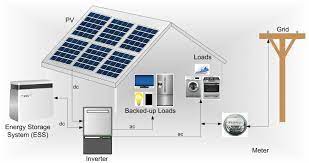In today’s rapidly evolving world, the demand for sustainable energy solutions has never been greater. With rising concerns about climate change and the depletion of traditional energy sources, individuals and communities are increasingly turning to alternative methods to power their homes. One such solution that has gained traction in recent years is home energy storage. By harnessing the power of renewable energy sources like solar and wind, coupled with advanced battery technology, home energy storage systems offer a promising pathway towards a more sustainable future.
The Rise of Home Energy Storage
The concept of home energy storage is simple yet revolutionary. Instead of solely relying on the grid for electricity, homeowners can generate and store their own energy using solar panels or wind turbines. These renewable energy sources produce electricity during the day when the sun is shining or the wind is blowing, but often generate more power than is immediately needed. Home energy storage systems allow excess energy to be stored in batteries for later use, providing a reliable and sustainable source of power even when the sun sets or the wind dies down.
Key Components of Home Energy Storage Systems
At the heart of any home energy storage system are the batteries. These batteries come in various forms, including lithium-ion, lead-acid, and flow batteries, each with its own unique advantages and disadvantages. Lithium-ion batteries, for example, are lightweight and compact, making them ideal for residential applications where space is limited. Lead-acid batteries, on the other hand, are more affordable but have a shorter lifespan and require regular maintenance.
In addition to batteries, home energy storage systems also include inverters, which convert the direct current (DC) electricity generated by solar panels or wind turbines into alternating current (AC) electricity that can be used to power household appliances. Smart monitoring and control systems allow homeowners to track their energy usage in real-time and optimize their systems for maximum efficiency.
Benefits of Home Energy Storage
The benefits of home energy storage are manifold. First and foremost, it allows homeowners to reduce their reliance on the grid, thereby lowering their electricity bills and providing greater energy independence. By generating and storing their own electricity, homeowners can also insulate themselves from fluctuations in energy prices and power outages caused by grid failures or natural disasters.
Furthermore, home energy storage systems play a crucial role in promoting the widespread adoption of renewable energy sources. By incentivizing homeowners to invest in solar panels or wind turbines, these systems help drive demand for clean energy technologies and accelerate the transition towards a more sustainable energy future.
Environmental Impact
Perhaps the most compelling argument in favor of home energy storage is its positive impact on the environment. By generating electricity from renewable sources like the sun and wind, homeowners can significantly reduce their carbon footprint and mitigate the harmful effects of climate change. According to the U.S. Environmental Protection Agency, residential buildings are responsible for approximately 20% of the country’s greenhouse gas emissions, the majority of which come from the combustion of fossil fuels for heating, cooling, and electricity generation. By transitioning to renewable energy sources and implementing energy storage systems, homeowners can help reduce emissions and contribute to a cleaner, healthier planet for future generations.
Challenges and Considerations
Despite its many benefits, home energy storage is not without its challenges. One of the primary barriers to widespread adoption is the high upfront cost of installing solar panels or wind turbines and purchasing batteries. While prices have fallen significantly in recent years, many homeowners still perceive renewable energy systems as prohibitively expensive. Additionally, the intermittent nature of renewable energy sources means that home energy storage systems may not always be able to meet the demands of households with high energy usage or limited access to sunlight or wind.
Moreover, the disposal of batteries at the end of their lifespan poses environmental concerns, as certain types of batteries contain toxic chemicals that can leach into the soil and water if not properly managed. Efforts are underway to develop more sustainable battery technologies and recycling programs to address this issue, but further research and investment are needed to ensure that home energy storage remains an environmentally friendly solution.
The Future of Home Energy Storage
Despite these challenges, the future of home energy storage looks promising. Advances in battery technology, coupled with declining costs and growing public awareness of the need for sustainable energy solutions, are driving increased interest and investment in residential energy storage systems. Government incentives and rebates further incentivize homeowners to invest in renewable energy and energy storage, making it an attractive option for those looking to reduce their carbon footprint and save money on electricity bills.
As technology continues to improve and economies of scale are realized, home energy storage systems are expected to become even more affordable and efficient, further accelerating their adoption worldwide. With the potential to revolutionize the way we power our homes and combat climate change, home energy storage holds tremendous promise as a key component of a sustainable energy future. By harnessing the power of the sun and wind and storing it for later use, homeowners can take control of their energy destiny and help build a cleaner, greener world for generations to come.

